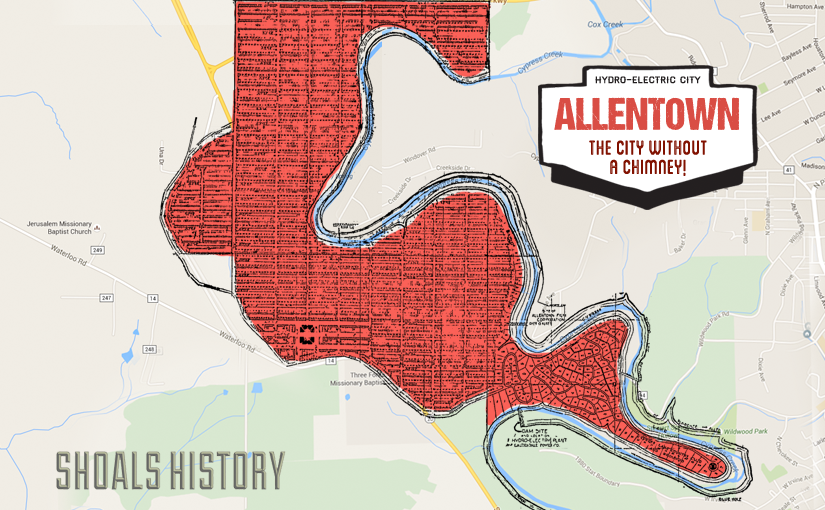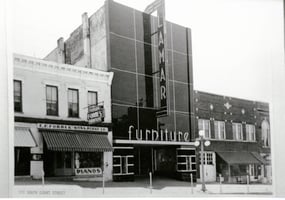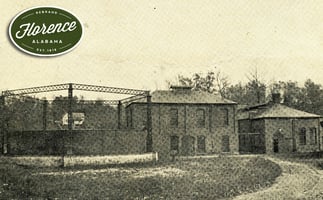In the charming town of Sheffield, Alabama, a coffee legacy was born in 1929. The Alabama Coffee...
Allentown – The city without a chimney
The Idea
Billed as the biggest opportunity North Alabama ever saw, Allentown was to become a new industrial development powered completely by hydro-electric power from two dams built on Cypress Creek. The “City Without A Chimney”, read a tagline used in all advertisements. The basis of Allentown was to be cheap electric power, water transportation, entrancing landscape scenery, and unrivaled sites for manufacturing industries.
Incorporated on September 23, 1914 with a capital stock of $200,000 (nearly $4.7 million in today’s dollars), Allentown Power Company’s plan was to develop the water power on Cypress Creek, subdivide the land and to build two hydro-electric power plants. Col. N.F. Thompson of Birmingham was president, and T.W. Pratt of Huntsville was vice president. The company operated out of the ground floor of the Jefferson Hotel in downtown Florence. The next month, however, would see the resignation of both gentlemen (a likely sign of Allentown’s future failure) with Mr. Sloan Jacobs of Birmingham being elected as president and Mr. Alan L. Jemison, also of Birmingham, elected as vice president.
The Hype
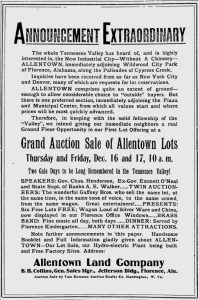
Surveyed by the Kelley Company out of Birmingham, the proposed tract of land measured in a straight line from north to south, two miles, and from east to west over two and a half miles. Allentown encompassed more than 1,000 acres over a total of five square miles which were subdivided into 6,500 lots. The unusual winding of Cypress Creek provided Allentown with a water line that was just over seven miles long. That not only meant that prospective Allentown citizens would have a choice of the most wonderfully beautiful waterfront property, but also a sizable amount of water for the hydro-electric plant. A dam that was 410 feet long and 42 feet high was to convert Cypress Creek above the dam into a beautiful, wide lake over 1,000 feet wide and over 4 miles long and a slightly narrower width for three more miles.
The Cypress Creek lake in Allentown was to be marketed as a must-see destination for boaters, canoeing, fishing, hunting and recreation of all sorts. They hoped to attract tourists from all across the country to camp, picnic, and relax in this lush new paradise. Wildwood Park at the time would have been expanded with a new harbor to dock the boats and other watercraft.
Not long after the announcement of such a wondrous new town, the “City without a chimney” already had over 50 local Florence residents who announced their intentions to move into Allentown. Such good news led those involved to say that they wouldn’t have to send invitations for residents, but would rather be able to eliminate from the inundation of requests and pick out only the best citizens for Allentown.
The Spectacle
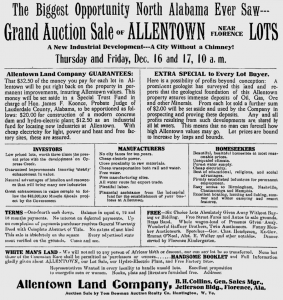 In mid-December of 1915, the Allentown Land Company held a two-day auction event to sell lots from the central section of Allentown. In the days leading up to this spectacle, the grounds were meticulously cleaned. Trees were whitewashed and trimmed, the streets were laid off with several of the more important streets having been graded too. The lots were all marked out, and each lot would be sold from a big wagon driven upon the lot itself. The famous Irish “Twin Auctioneers” called the Gaffney Brothers were brought in to wow the crowd with synchronized auction calling. A brass band playing only the best music paraded the streets of Sheffield and Tuscumbia leading a large crowd back to Allentown on street cars. After several speeches (including some from the current Governor as well as ex-governor O’Neal), the bidding started and didn’t let up until late in the afternoon. Almost immediately, 40 lots were bought up by excited new residents. The first lot was sold to Mr. M.P. Johnson of Iuka, Mississippi. A free lot was given as a prize and won by Mr. L. Rickard of Florence. Every 30 minutes more prizes were given out to the crowd of people.
In mid-December of 1915, the Allentown Land Company held a two-day auction event to sell lots from the central section of Allentown. In the days leading up to this spectacle, the grounds were meticulously cleaned. Trees were whitewashed and trimmed, the streets were laid off with several of the more important streets having been graded too. The lots were all marked out, and each lot would be sold from a big wagon driven upon the lot itself. The famous Irish “Twin Auctioneers” called the Gaffney Brothers were brought in to wow the crowd with synchronized auction calling. A brass band playing only the best music paraded the streets of Sheffield and Tuscumbia leading a large crowd back to Allentown on street cars. After several speeches (including some from the current Governor as well as ex-governor O’Neal), the bidding started and didn’t let up until late in the afternoon. Almost immediately, 40 lots were bought up by excited new residents. The first lot was sold to Mr. M.P. Johnson of Iuka, Mississippi. A free lot was given as a prize and won by Mr. L. Rickard of Florence. Every 30 minutes more prizes were given out to the crowd of people.
Although day two of the auction had to be postponed for 3 days due to a wet and dreary day, the construction crew still got out there early in the morning for the installation of their turbine and generator. They had the lights on in Allentown at exactly 11:44 a.m. The small crowd of around 100 people who braved the rain gave a loud cheer as Allentown was lit for the first time by their own hydro-electric power from Cypress Creek.
The failure
Despite the large spectacle, a handful of pre-sold lots, and plenty of national marketing Allentown never came to full fruition. The result of corporate mergers, litigations, and lawsuits, Allentown was never meant to be. The main lawsuit made it all the way to the Alabama Supreme Court on November 28, 1918. Allentown Power Company had consolidated with the Lauderdale Power Company and its proprietors were sued for failing to begin work on the development of the water power necessary to power Allentown.
The original contract was signed on July 3, 1914. The power company called for a time extension for the completion of work and the contract was modified to show that extension 4 separate times into November of that same year. Lots of back and forth between parties finally resulted in an agreement to separate the water power from the other interests in the lands. It was also agreed that if the power company failed to make payment for their option to develop water power on the property within 50 days, that the contract would be void. That payment was never made. The landowner did what he reasonably could to enable Lauderdale Power Company and their associates to make the purchase; and then, when his patience was apparently exhausted, and after the expiration of all extended time limits, he gave the option to a different party.
It is true that a crude, temporary small electric power plant was constructed by the power company, but the Alabama Supreme Court ruled that this did not constitute ‘for continuous development of the water power.’ Without hydro-electric power, the “City without a chimney” could never come to fruition.
